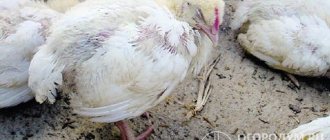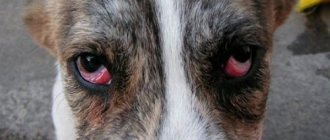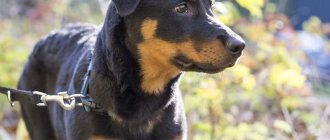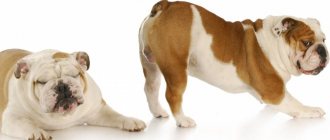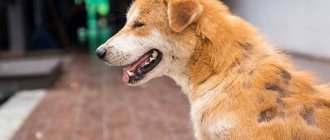When asked why Yorkies have watery eyes, some owners answer that this is a feature of the breed. But experts say that tearfulness is a problem that needs to be solved. It’s one thing when the mucous membrane brings debris and dust to the surface, and these accumulations are easy to remove. But when your eyes water constantly and profusely, or the discharge is cloudy or purulent, you need to sound the alarm. After all, eye diseases occur more often in Yorkies than usual.
Discomfort from lacrimation makes Yorkies sad, and the pet loses interest in games and walks.
Types of conjunctivitis
Conjunctivitis is an inflammation of the organs of vision. This disease affects the mucous membranes that cover the eyeballs and eyelids. Most often, the reason when a Yorkie's eyes fester is reduced immunity or some kind of chronic disease.
There are 4 types of conjunctivitis:
- catarrhal;
- purulent;
- allergic;
- follicular.
Catarrhal - appears when the Yorkie's eyeball is injured or infected.
This type is accompanied by:
- hyperemia;
- redness;
- swelling of the eyelids;
- purulent and lacrimal discharge.
Purulent - can develop if bacteria or pathogens get on the membrane of the Yorkie's eyes. Typically, this type of conjunctivitis spreads very quickly. The disease has a complicated form.
Yorkie symptoms:
- swelling of the eyelids;
- general increase in body temperature;
- hot nose;
- fear of light;
- vomit.
In severe complications, corneal clouding may occur.
Expert opinion
Anna Abramenko
An avid dog lover. Experience in veterinary medicine since 2009.
Ask a Question
If you ignore treatment for conjunctivitis, your dog may lose its vision.
Allergic - this type often manifests itself in animals with weak immunity. For such a disease to occur, it is enough that any allergen gets on the conjunctiva or mucous membrane of the animal.
Symptoms:
- eyelids and corneas turn red;
- eyes are streaming.
Follicular - can occur if dust, dirt or foreign body particles get on the membrane of the Yorkie's eye. The eyelid and its lymphatic follicle are affected. This disease is accompanied by:
- severe redness;
- copious purulent discharge;
- Lymphatic follicles accumulate on the surface of the eyelids.
In case of complications, the follicular appearance becomes catarrhal.
Expert opinion
Anna Abramenko
An avid dog lover. Experience in veterinary medicine since 2009.
Ask a Question
All types of disease have forms: acute and chronic. The first is curable, and the second either subsides or progresses.
When to contact a veterinarian
Advanced ophthalmological diseases can lead to blindness, so it is very important not to delay diagnosis if alarming signs occur. These include:
- pain on palpation of the eyeballs;
- swelling of the eyelids;
- squinting in bright light;
- scratching the muzzle and eyelids with paws, accompanied by plaintive whining;
- redness of mucous membranes;
- increased tearfulness, change in color and consistency of discharge;
- increase in temperature;
- prolonged apathy, deterioration or lack of appetite.
These symptoms are characteristic of allergies, viral infections, hormonal disorders and other pathologies. The exact cause of the malaise is determined only on the basis of tests. Depending on the results, the veterinarian will tell you how to wash the dog’s eye from pus and how to eliminate the root cause of the disease.
Reasons for appearance
Conjunctivitis in the Yorkshire Terrier can be caused by pathogens. They enter from the external environment onto the surface of the eyeball, protected by the conjunctiva, and penetrate the conjunctival sac. If a dog’s immune system is weakened, an inflammatory process occurs, after which it develops into a complicated disease.
Reasons for the development of conjunctivitis in Yorkies:
- eye damage;
- irritation;
- inflammation of the eyelid and cornea;
- contact with the conjunctiva of dust, fluff, wool, dirt;
- infection;
- burn, frostbite;
- lack of vitamins A, their deficiency;
- the puppy is prone to allergies;
- viruses, fungi;
- Yorkie metabolic disorder;
- arbitrary ingrowth of eyelashes into the eyelid.
Expert opinion
Anna Abramenko
An avid dog lover. Experience in veterinary medicine since 2009.
Ask a Question
Yorkshire terriers are among the dogs at risk for conjunctivitis. It is recommended to carefully monitor the animal’s eyes, check them periodically, perform preventive measures and treat them with special means.
Whitening shampoos for dogs
Most dog coat bleaching shampoos contain a bluing agent , which gives white fur a blue tint that is perceived as white by the human eye. The optical illusion is achieved due to the fact that the blue or purple color coloring the ends of the hair reflects light, and the coat appears lighter, whiter. But the white effect is achieved only in the presence of faint yellow spots. After using a bluing agent, it is necessary to wash it again with regular shampoo so that the coat does not acquire a concentrated blue color. You cannot use several whitening shampoos at the same time. For example, using a bluing shampoo after a bleaching shampoo can cause your hair to turn blue.
Enzyme-based lightening shampoos remove yellow stains from saliva and tears, allowing you to achieve the desired result. But the product acts harshly, removing the outer layer of each hair. Therefore, it is not recommended to use enzymatic shampoos frequently. It is usually used with a good conditioner that has a restorative effect.
Whitening shampoos for dogs contain aggressive chemicals that help achieve whiteness, but if used incorrectly can cause dry, irritated skin. Such aggressive substances include hydrogen peroxide, which increases the pH level, thereby bleaching hair.
The effect of all shampoos is enhanced by using warm water, which promotes deeper cleansing of impurities from the hair. But it is better to rinse off the shampoo with cool water, which helps close the hair scales. The active ingredients are fixed inside the hair, after drying, maximum reflection of light occurs, achieving the effect of whiteness and radiance. Beaphar, 8in1, Mr. cosmetics work well. Bruno, Espree, All Systems, Chris Christensen.
Signs and symptoms
For all types of conjunctivitis, the symptoms are similar:
- redness of the mucous membrane of the eye;
- excessive tearing;
- loss of hair around the eyelids and eyelashes;
- swelling;
- the appearance of purulent or mucous discharge.
When the disease occurs, your Yorkie experiences discomfort and a strong burning sensation (in the eye area). Behaves nervously or passively, often scratches your eyelids with your paw and squints your eyes.
Eye diseases
Tear fluid includes three types:
- Aqueous - begins to be produced by special glands that are located around the orbit of the eye.
- The fat or sebaceous fraction is produced by the meibomian gland, which is located between the cartilage of the eyelid and the conjunctiva, which open on the free edge of the eyelid. They perform a special role as a barrier, which prevents tears from rolling over the edge of the lower eyelid and their further evaporation.
- A moisturizing, otherwise mucin, fraction, which is produced by goblet cells of the conjunctival membrane, secreting a special mucin, which creates a special contact of the tear fluid.
Diseases that disrupt the process of tear formation should be divided into two groups: a lack of tear fluid (aka dry eye) or its excess (watery eye).
First aid
If it is not possible to take your Yorkshire Terrier to a veterinarian, you must immediately provide him with first aid. To do this, you can resort to treatment methods with folk remedies.
Operating principle:
- Wipe the affected area, remove the pus that has accumulated in the corners of the Yorkie's eye or under it. To do this, you need to take a piece of cotton wool, soak it in tea leaves or strong tea and wipe off the exudate.
- After 10-20 minutes, apply ointment (tetracycline or penicillin) to the inner corner of the Yorkie's eyelid.
The course must be carried out 3-4 times a day for two to three weeks. The dosage and medications are prescribed directly by veterinarians.
Severe irritation can be easily relieved with almond oil, which can be injected into the Yorkie's eye, one drop from a pipette.
Thanks to such actions, the owner will relieve his pet from sharp, painful pain. If you don’t have any medications on hand, you can buy the herb “eyebright” at the pharmacy. Infuse the plant for three hours (1 glass of hot water per 10 g). Wash your eyes with the resulting solution and make lotions (compresses).
Even after first aid, your Yorkie must be taken to a specialist for an examination and then treated for the eyes under the supervision of a veterinarian.
We should not forget that the animal is a carrier of the disease, which can also infect humans. It would be a good idea for the owner of the Yorkie to get checked at the clinic.
What is important to know first?
York is a very fragile creature. The average life expectancy is from 12 to 14 years. The animal must weigh no more than 3150 grams. in adulthood.
The breed is very friendly to both people and other animals. A distinctive feature is devotion to the owner and “ability to listen.” It's funny to watch how the baby tilts her head to the side thoughtfully when people chat with her. In addition, psychologists have long proven that Yorkies have a positive effect on the human psyche.
The advantages of keeping a Yorkie are that it does not shed, and there is no hair on clothes, furniture or in the food plate. There is no specific smell either.
Treatment methods
There are several ways to treat conjunctivitis in animals. It all depends on the type, form, neglect and complications of the disease. The procedures can be carried out in natural home conditions, but under the supervision of a doctor.
Drug therapy
To rid your pet of conjunctivitis, treatment is prescribed.
The veterinarian may prescribe for a Yorkie:
- ointments that relieve inflammation;
- antibiotics;
- eye drops;
- medicines for oral use, tablets, mixture.
- vitamins that strengthen the immune system.
Traditional methods
These methods are mainly used by experienced breeders and dog handlers. It is necessary to wipe the Yorkie's eye area and apply lotions on them. You can use one of the solutions for this: tea, calendula, chamomile, eyebright, furatsilin or potassium permanganate. It would be a good idea to inject a few drops of iris oil into your pet's eyes.
How to treat
What to do if the cause of your dog's lacrimation is related to a disease? If this is a general disease of an infectious nature, then the tears will stop flowing as soon as the underlying disease is cured.
For inflammatory eye diseases - conjunctivitis, uevitis, keratitis, complex treatment is prescribed, including anti-inflammatory, antibacterial drugs, which are applied to the eye in the form of drops or ointments. If necessary, veterinarians recommend additional medications in tablets or injections.
The most popular drugs used to treat conjunctivitis, keratitis, and blepharitis in dogs are veterinary drops - “Tsiprovet”, “Bars”. They contain antibiotics that are active against gram-positive and gram-negative microorganisms and also have an anti-inflammatory effect.
Glaucoma in dogs has practically no treatment, only drugs are prescribed that lower intraocular pressure and alleviate the animal’s condition.
For lacrimation associated with pathologies of the lacrimal system, surgical intervention is most often necessary. During the operation, the patency of narrowed, overgrown or blocked areas is restored, after which tear drainage begins to occur normally.
Watery eyes in a dog suffering from allergies due to poor diet or exposure to external factors will return to normal after the animal’s contact with the allergen stops. Additionally, the doctor may prescribe antihistamines.
To preventively moisturize the surface of a dog’s eye in a dry room, you can use “Diamond Eye” or “Optimmune” drops.
Preventive measures and care
To prevent conjunctivitis, good eye care for your Yorkshire Terrier is essential. The main thing is to properly care for your dog and comply with sanitation and hygiene standards. The place for the animal should be dry, clean, the bedding for the Yorkie should be replaced (every 10 days).
Any pet can get conjunctivitis. But if you give him first aid and go to the veterinary clinic in time, complications can be avoided.
Other whitening cosmetics
whitening gel (USA) provides safe and effective removal of stains from urine, tears, saliva, food, and also strengthens hair. The transparent gel is applied to dry fur with a brush or hands. It is removed after some time or remains on the coat for 2-3 days. Fresh stains are removed without a trace after 1-2 applications of the gel. Old stains require more time to remove - use the gel daily for 7-10 days. The cost of the gel is about 1300 rubles.
Whitening spray conditioner Ring5 Whitener Cleaner (USA) enhances whiteness (optical illusion), preserves the natural silky texture of the hair and adds volume. The cosmetic mask masks the yellowish tint and removes dust.
Conditioner Anti-Yellowing eliminates yellowness, restores and strengthens hair. Does not cause irritation and does not cause dryness. The conditioner is applied after washing the coat with shampoo (Iv San Bernard Cristal Clean Shampoo Anti-Yellowing whitening shampoo is available on sale) for a few minutes, then rinsed off with water. The cost of an air conditioner is approximately 1200 rubles.
In cases where the coat is lightly colored, a whitening effect can be achieved by using gentle cosmetics that contain natural moisturizers of natural origin (hyaluronic acid, chitosan), coconut oil, and vitamins.
Prevention
Eye rinsing in both cats and dogs is an effective preventive measure. This is especially true for those dogs that have a predisposition to diseases of the organs of vision (blepharitis, glaucoma, cataracts). Diseases require complex treatment and washing alone is no longer sufficient. This procedure can significantly reduce the risk of their development to a minimum.
Wipe the dog's eyes with a napkin
Necrotizing encephalitis
Necrotizing encephalitis has been poorly studied and is practically untreatable.
Most common symptoms:
- decreased appetite;
- weight loss;
- limping;
- lack of coordination;
- sudden change in behavior;
- pain;
- convulsions.
Timely detection of symptoms of the disease and contacting a clinic can, despite the poor prognosis for this disease, lead to positive results.
As a result of the examination, the veterinarian will prescribe surgical or other treatment.
What not to do if you have watery eyes
Having discovered severe tearing, every owner wants to help their pet. But you have to be careful not to harm him.
If there is a strong secretion of tear fluid, it is not recommended:
- Touch the sore spot with dirty hands. You can get an infection.
- Apply tea and alcohol-based solution onto the cornea. The drugs irritate it, causing inflammation.
- Use cotton wool. The fibers stick to the mucous membrane and cause discomfort. Smooth cotton pads are suitable for the procedures.
- Apply cosmetics in the form of sprays and aerosols around the dog. Tobacco smoke also irritates the peephole.
- Try to identify the disease and treat the animal yourself. You need to contact your veterinarian for help.
Consultation with a veterinarian to identify the disease
By following these rules, the owner will not harm the health of his dog.
Recommended vaccinations
Professional dog breeders advise using drugs from foreign manufacturers to vaccinate Yorkies:
- NobivakLepto;
- NobivakDHPPI;
- Hexadog;
- Eurican.
It is necessary to re-vaccinate as it expires after a year. These drugs have gained popularity due to the fact that pets tolerate them well.
What do Yorkies get sick of?
Yorkies are healthy enough not to be considered sickly dogs.
However, after talking with veterinarians and owners of Yorkshire terriers, and studying a lot of literature, we received a rather impressive list of possible breed and other diseases.
Mostly these “others” are a consequence of the size of the Yorkie.
By the way, one of the first places is occupied by the traumatic nature of Yorkies due to human negligence, so the breed is not suitable for all children.
And yet, most often, sensitive Yorkies suffer from colds and allergies to everything.
We want you to find this article useful and may your pet be healthy. But “forewarned means...”. We arm in general.
Washing
First you need to prepare your inventory. There is no need to first restrain the dog or hold its head in any way, since the procedure is not a source of stress for the pet. You can only hold your pet's head for comfort.
Advice! To maintain hygiene, the eyes are wiped with different sides of a cotton pad or napkin.
First, the owner must wash his hands thoroughly with soap. Ideally, this soap will be laundry soap. Next, soak a cotton pad or gauze pad in the solution. It is advisable that the solution be warm or at room temperature. An infusion that is too cold will be extremely unpleasant for the dog.
Now you can begin the procedure itself. Use a damp disc to wipe the eyes from the ears to the nose with smooth and careful movements (and nothing else!). If you wipe in the other direction, the dirt will get into the pouch under the eyelid, and this is fraught with the development of an inflammatory process. If pus continues to discharge after several washes, you should take your pet to see a veterinarian.

